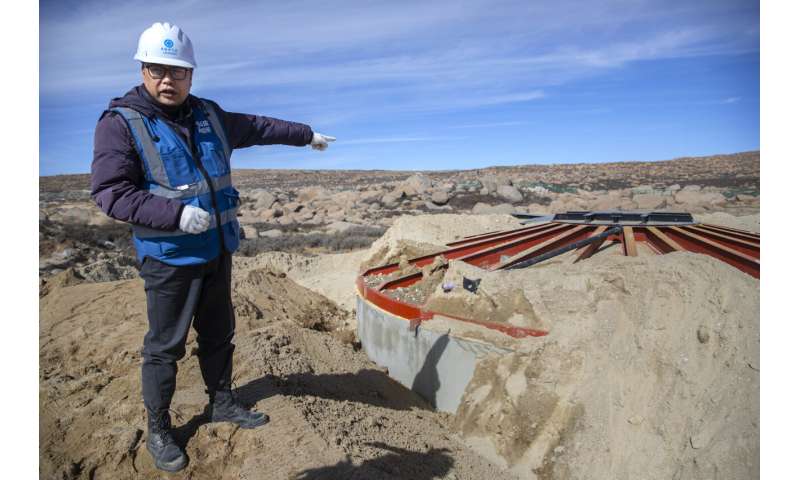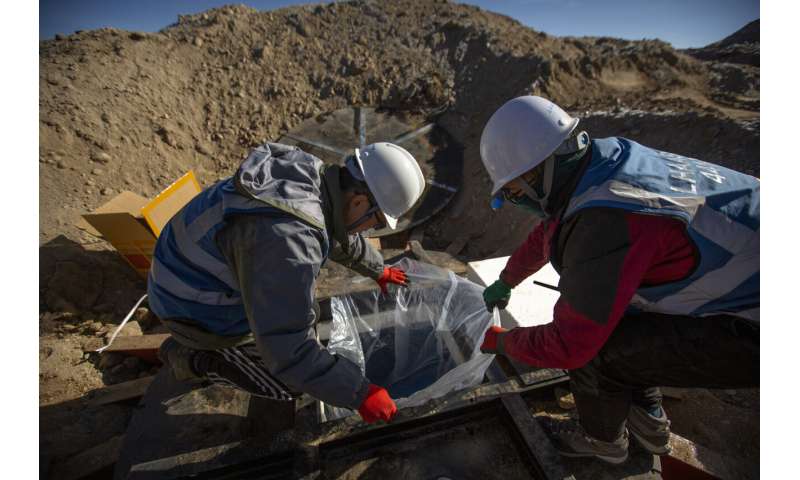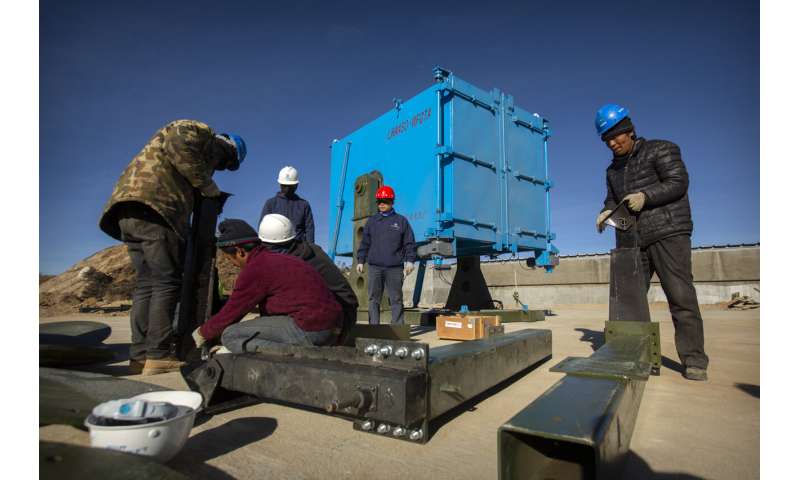New detector finds gamma rays from surprising cosmic sources

Astrophysicist Cao Zhen opens a steel hatch on a windswept Tibetan Plateau and climbs down a ladder into inky darkness. His flashlight picks out a boat floating on a pool of purified water above thousands of glittering orbs the size of beachballs.
He's inside a $175 million observatory that isn't technically complete but has already discovered something tantalizing: bursts of gamma rays from outer space that may someday help explain how matter is created and distributed across the universe.
The Large High Altitude Air Shower Observatory, the biggest device of its kind, has detected a dozen sources of ultra high-energy gamma rays, according to a study in the journal Nature, from what Cao calls "many hot spots," in our Milky Way galaxy.
Gamma rays with such high energy have never been detected before, and the findings suggest these rays can come not just from dying stars, but are also generated inside massive young stars.
"These results are really stunning—some of the most exciting I have ever seen," said Alan Watson, an astrophysicist working with the Pierre Auger Observatory in Argentina.
Cao's team traced 530 high-energy gamma rays to 12 sources including a massive cluster of young stars called the Cygnus Cocoon and the interstellar cloud called the Crab Nebula.

Gamma rays are a type of extreme radiation generated by the hottest and brightest explosions in the universe, like when a large star implodes. Those implosions also create the matter that make up planets—and everything that lives on them, including us. Of all the electromagnetic waves in the universe, gamma rays have the smallest wavelengths and the most energy. They can release more energy in 10 seconds than our sun in 10 billion years.
The pool of purified water at LHAASO that Cao paddled across measures the subatomic shrapnel—the "air shower" in the observatory's name—created when gamma rays and high energy particles called cosmic rays crash into the Earth's atmosphere.
The shrapnel includes mysterious particles called muons that can be seen as faint blue flashes known as Cherenkov radiation in the observatory's dark water. The array of 3,120 beachball-sized globes contain tiny sensors that measure the radiation.

"We can trace these gamma rays back to their source in the sky," said Cao, dressed in blue scrubs to keep the water clean. "We can find something new."
LHAASO is one of dozens of devices on Earth and in orbit—suspended in ice tunnels in Antarctica or inside toaster-sized satellites—trying to understand how matter such as carbon, oxygen and iron came to be.
Located near the 4,400-meter-tall (14,500-foot-tall) Haizi Mountain, it houses separate instruments that can study different phenomena, including cosmic rays, high energy subatomic particles that scientists believe come from the same sources as gamma rays. Cosmic rays are like sparks from a massive stellar crucible—each contains flecks of material from the forging process. Gamma rays are more like light from a glowing hearth. By studying both, the observatory can learn more about what generated them.
-

Chinese astrophysicist Cao Zhen navigates a boat across a water-filled cavern with 3,120 submerged globes with sensors used to detect Cherenkov light at the Large High-Altitude Air Shower Observatory (LHAASO) at Haizi Mountain near Daocheng in southwestern China's Sichuan Province, Friday, Nov. 8, 2019. The LHAASO, the biggest device of its kind, has detected a dozen sources of ultra high-energy gamma rays from within our Milky Way galaxy, according to a new study in the journal Nature.Credit: AP Photo/Mark Schiefelbein -

Chinese astrophysicist Cao Zhen, left, climbs into a boat in a large water-filled cavern with 3,120 instruments to detect Cherenkov light at the Large High-Altitude Air Shower Observatory (LHAASO) at Haizi Mountain near Daocheng in southwestern China's Sichuan Province, Friday, Nov. 8, 2019. The LHAASO, the biggest device of its kind, has detected a dozen ultra high-energy gamma rays, according to a new study in the journal Nature. Credit: AP Photo/Mark Schiefelbein -

In this aerial photo, a building housing a water-filled cavern with sensors for Cherenkov light and mounds of dirt covering instruments to detect muon particles originating from outer space are seen at the Large High-Altitude Air Shower Observatory (LHAASO) at Haizi Mountain near Daocheng in southwestern China's Sichuan Province, Saturday, Nov. 9, 2019. The LHAASO, the biggest device of its kind, has detected a dozen sources of ultra high-energy gamma rays from within our Milky Way galaxy, according to a new study in the journal Nature. Credit: AP Photo/Sam McNeil -

Chinese astrophysicist Cao Zhen gestures while talking about a model of the Large High-Altitude Air Shower Observatory (LHAASO) at the Institute of High Energy Physics in Beijing, Wednesday, May 19, 2021. The LHAASO, the biggest device of its kind, has detected a dozen sources of ultra high-energy gamma rays from within our Milky Way galaxy, according to a new study in the journal Nature. Credit: AP Photo/Sam McNeil -

Chinese astrophysicist Cao Zhen stands near a metal lid covering equipment to detect muon particles originating from outer space at the Large High-Altitude Air Shower Observatory (LHAASO) at Haizi Mountain near Daocheng in southwestern China's Sichuan Province, Friday, Nov. 8, 2019. The LHAASO, the biggest device of its kind, has detected a dozen sources of ultra high-energy gamma rays from within our Milky Way galaxy, according to a new study in the journal Nature. Credit: AP Photo/Mark Schiefelbein -

Members of the Buddhist faithful circle the Tibetan-style White Pagoda in Daocheng, the town nearest to China's Large High-Altitude Air Shower Observatory (LHAASO) in southwestern China's Sichuan Province, Saturday, Nov. 9, 2019. The LHAASO, the biggest device of its kind, has detected a dozen sources of ultra high-energy gamma rays from within our Milky Way galaxy, according to a new study in the journal Nature. Credit: AP Photo/Mark Schiefelbein -

People play basketball on a court near Tibetan-style buildings in Daocheng, the town nearest to China's Large High-Altitude Air Shower Observatory (LHAASO) in southwestern China's Sichuan Province, Saturday, Nov. 9, 2019. The LHAASO, the biggest device of its kind, has detected a dozen sources of ultra high-energy gamma rays from within our Milky Way galaxy, according to a new study in the journal Nature.Credit: AP Photo/Mark Schiefelbein -

Technicians check equipment to detect muon particles originating from outer space before it is buried in a mound of dirt at the Large High-Altitude Air Shower Observatory (LHAASO) at Haizi Mountain near Daocheng in southwestern China's Sichuan Province, Saturday, Nov. 9, 2019. The LHAASO, the biggest device of its kind, has detected a dozen sources of ultra high-energy gamma rays from within our Milky Way galaxy, according to a new study in the journal Nature. Credit: AP Photo/Mark Schiefelbein -

Technicians check equipment to detect muon particles originating from outer space before it is buried in a mound of dirt at the Large High-Altitude Air Shower Observatory (LHAASO) at Haizi Mountain near Daocheng in southwestern China's Sichuan Province, Saturday, Nov. 9, 2019. The LHAASO, the biggest device of its kind, has detected a dozen sources of ultra high-energy gamma rays from within our Milky Way galaxy, according to a new study in the journal Nature. Credit: AP Photo/Mark Schiefelbein -

Construction workers prepare to install one of 18 wide-field air Cherenkov telescopes at the Large High-Altitude Air Shower Observatory (LHAASO) at Haizi Mountain near Daocheng in southwestern China's Sichuan Province, Saturday, Nov. 9, 2019. The LHAASO, the biggest device of its kind, has detected a dozen sources of ultra high-energy gamma rays from within our Milky Way galaxy, according to a new study in the journal Nature.Credit: AP Photo/Mark Schiefelbein -

Construction workers install one of 5,195 electromagnetic particle detectors at the Large High-Altitude Air Shower Observatory (LHAASO) at Haizi Mountain near Daocheng in southwestern China's Sichuan Province, Saturday, Nov. 9, 2019. The LHAASO, the biggest device of its kind, has detected a dozen sources of ultra high-energy gamma rays from within our Milky Way galaxy, according to a new study in the journal Nature. Credit: AP Photo/Mark Schiefelbein -

A construction worker moves a cable next to a mound of dirt covering equipment to detect muon particles originating from outer space at the Large High-Altitude Air Shower Observatory (LHAASO) at Haizi Mountain near Daocheng in southwestern China's Sichuan Province, Saturday, Nov. 9, 2019. The LHAASO, the biggest device of its kind, has detected a dozen sources of ultra high-energy gamma rays from within our Milky Way galaxy, according to a new study in the journal Nature. Credit: AP Photo/Mark Schiefelbein -

A construction worker stands in a trench next to a building housing a water-filled cavern with equipment to detect Cherenkov light from gamma rays originating from outer space at the Large High-Altitude Air Shower Observatory (LHAASO) at Haizi Mountain near Daocheng in southwestern China's Sichuan Province, Saturday, Nov. 9, 2019. The LHAASO, the biggest device of its kind, has detected a dozen sources of ultra high-energy gamma rays from within our Milky Way galaxy, according to a new study in the journal Nature. Credit: AP Photo/Mark Schiefelbein -

Construction workers arrive for a day of work at the Large High-Altitude Air Shower Observatory (LHAASO) at Haizi Mountain near Daocheng in southwestern China's Sichuan Province, Saturday, Nov. 9, 2019. The LHAASO, the biggest device of its kind, has detected a dozen sources of ultra high-energy gamma rays from within our Milky Way galaxy, according to a new study in the journal Nature. Credit: AP Photo/Mark Schiefelbein -

Chinese astrophysicist Cao Zhen, right, puts on a protective suit before entering a large cavern equipped with instruments to detect Cherenkov light from gamma rays at the Large High-Altitude Air Shower Observatory (LHAASO) at Haizi Mountain near Daocheng in southwestern China's Sichuan Province, Friday, Nov. 8, 2019. The LHAASO, the biggest device of its kind, has detected a dozen ultra high-energy gamma rays, according to a new study in the journal Nature. Credit: AP Photo/Mark Schiefelbein
The Chinese observatory offers "unprecedented sensitivity," said Avi Loeb, a Harvard University astrophysicist, that may, for example, help physicists tell whether if some rays come from inside our galaxy or farther away.
It's not yet complete, however. Cao said that by the end of June the instruments will be in place, including 5,195 electromagnetic detectors, 1,188 muon detectors, and 18 Cherenkov telescopes each the size of a shipping container that will study air showers in the sky.
"The outcome really justifies the massive effort," Watson said of the new findings. "This is just the tip of the iceberg."
More information: Zhen Cao et al, Ultrahigh-energy photons up to 1.4 petaelectronvolts from 12 γ-ray Galactic sources, Nature (2021). DOI: 10.1038/s41586-021-03498-z
Journal information: Nature
© 2021 The Associated Press. All rights reserved. This material may not be published, broadcast, rewritten or redistributed without permission.



















